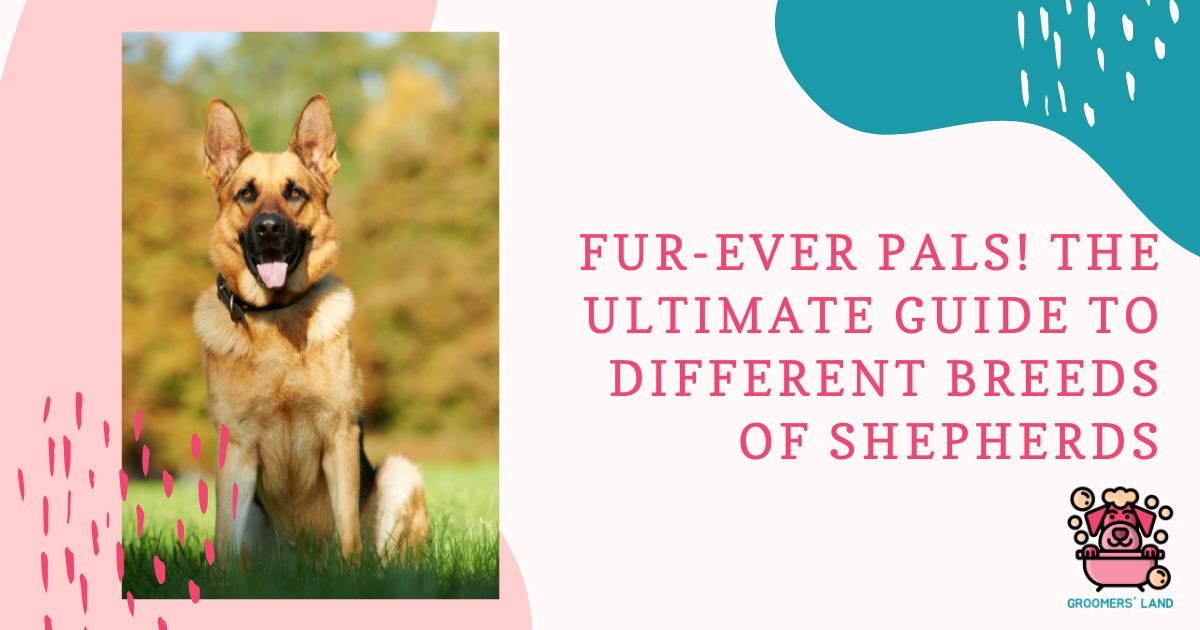How Many Different Breeds of Shepherds are There?
There are as many as 30 different breeds of Shepherds. Shepherd dogs or Sheepdogs come in a variety of sizes. A few are Corgis, others farm dogs, while others are guard dogs.
This article highlights a list of Shepherd dog breeds that excel on the field and make wonderful family pets. Read on to learn more about the different Shepherd types, the function of Shepherd dogs, breed examples, and their temperaments.
The Different Shepherd Breeds Listed
Australian Shepherd
This dog is a medium-sized herding dog that is still commonly used in the field today. It is a favorite herding dog frequently seen in rodeos.
These dogs exist in a variety of colors. The thickest part of their medium-length coat is around the neck. It’s a common misconception that these dogs came from Australia. Most people believe this dog breed was a European breed perfected in California. Still, the story of the Australian Shepherd is difficult to decipher due to a lack of reliable sources.
Nonetheless, the American Kennel Club first registered the Australian Shepherd in 1993, making it a relatively new breed on the list.
Aussies are not lazy and have an insatiable desire to herd. They are always looking for something to do, so they make excellent herding dogs for a large flock of sheep and occasionally cattle. Also, you can teach some Aussies to perform simple household tasks.
They may go out chasing cars or wandering unsupervised if not sufficiently stimulated. Additionally, they live well in large swaths of land, so you should provide them with an open space or a large yard.
They also excel in competitive obedience sports; however, you must rigorously train these dogs and adhere to a strict diet.
Australian Cattle Dog
Even though medium-sized, Australian Cattle Dogs can herd cattle on expansive lands. As the name suggests, the breed is from Australia. The breed originated when ranch owners and herders expanded westward from Sydney and required a reliable herding companion to manage vast ranch lands.
Australian Cattle Dogs are available in blue and red speckles and appear adaptable and easy to raise. They do not bark, snore, or drool excessively, adapt well to different climates, and shed only a few times yearly.
However, because they were initially bred to patrol vast tracts of land, they negatively reacted to confined living spaces. Consequently, they require extensive physical activity and mental stimulation to be happy.
Belgian Shepherd Dog
Since its origins in Belgium, the beautiful Belgian Shepherd has been a herding dog. It is also known as the Groenendael, Belgian Malinois, and Chien de Berger.
This medium-sized breed is ideal for the cool, wet climate of Belgium. The dogs average between 22 and 24 inches (55.9 and 60.9 centimeters) in height and have black coats. This double-layered coat is ideal for keeping the cold out and the body warm.
Belgian Shepherds enjoy activity and movement. Also, the police and law enforcement departments use them due to their ability to detect bombs and contraband. However, you need experience handling energetic canines to manage these dogs.
Additionally, Belgian Shepherd Dogs’ temperaments vary significantly from dog to dog, so one must be ready for the unexpected. Unquestionably, protective instincts are inherent to the Belgian Shepherd, so they will acquire knowledge naturally as they mature.
Belgian Malinois
The Belgian Malinois, registered with the AKC since 1959, is rapidly gaining popularity for police and military work. These dogs range in height from 22 to 26 inches (55.9 to 66 centimeters) and have manageable coats. Their coats are brown or fawn, and their ears and masks are black.
Belgian Malinois are popular for their exceptional intelligence and eagerness to please. Consequently, various army special forces worldwide have been utilizing them. They are frequently mistaken for German Shepherds, but their paws, coat, and head help distinguish them. Malinois have brown coats with smaller, more triangular ears and stand on their toes.
On the other hand, German Shepherds generally have tan coats with black saddles and larger ears and stand on their hind legs. Both dogs are extremely intelligent, but their temperaments differ slightly.
The Belgian Malinois possesses a strong prey drive and will pursue animals that are smaller than themselves. Unfortunately, this includes children, other pets, and wild squirrels. Without proper socialization, these dogs will not get along with other pets in the home.
In addition, these dogs possess a tremendous amount of energy and are typically very excitable and sensitive. You should not leave them alone, making them unsuitable for individuals who travel frequently or work long hours.
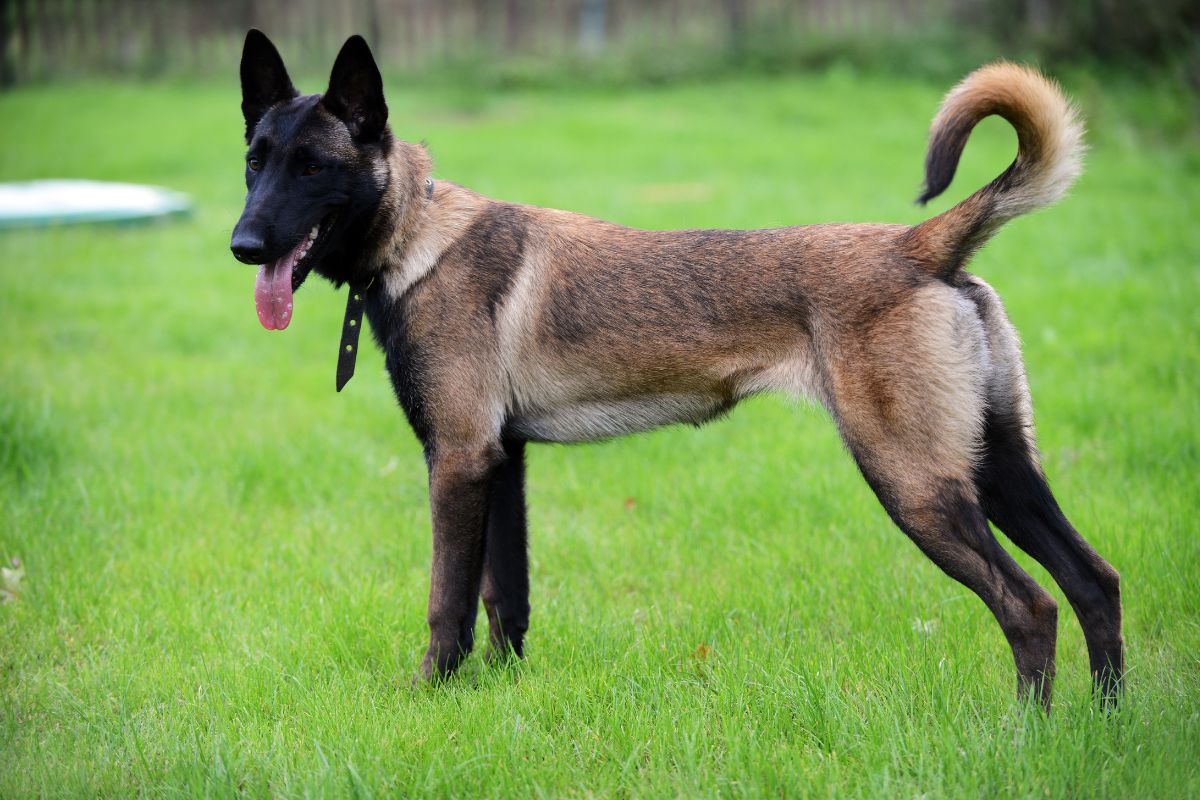
Beauceron
Beaucerons have been hunting dogs since the 1500s. They are tall, rugged dogs that come from the province of Brie. They have a black double coat with red feet, called bas-rouge, or “red stockings.”
Like several French Shepherd breeds, the Beauceron dogs have an extra dew claw on each hind leg. They are calm dogs who are protective of their families and full of energy.
Additionally, these dogs are particularly strong-willed and rarely submit to their master. This breed is not ideal for inexperienced dog owners! As is customary, you must socialize them at a young age.
Also, without proper training, they may assert dominance over children in the family, causing stress for the children and the dog. They also require at least 40 minutes to two hours of daily exercise and a large yard or farmland to run around in.
Berger Picard
The Berger Picard is one of France’s oldest herding dog breeds. Berger Picards are best known in the Northern hemisphere thanks to the 2005 film Because of Winn-Dixie, where Berger Picard played the titular dog.
They are another ancient breed from Picardy in Northern France. Many believe that the Berger Picard is the oldest of the French herding dog breeds because it has existed for ages.
Also, they received recognition in France in the 1960s, and the American Kennel Club registered them in 2015. These dogs are medium-sized breeds with rough, thick, and sturdy coats that can be red, blue, grey, or fawn. They also have tall, erect ears and a long tail with a slight J-curve.
Berger Picards are naturally skittish and easily overstimulated. As a result, a steady hand, lots of socialization, and positive reinforcement are necessary to ensure that they grow up happy and healthy.
Additionally, Berger Picards are sensitive to harsh voices, so training them gently, consistently, and firmly is critical. They can adjust to a small apartment if they get enough exercise. They’re also quiet dogs, so you’re less likely to wake up grumpy neighbors in the middle of the night.
Bohemian Shepherd
The Bohemian Shepherd is among the most underappreciated herding breeds. They are athletic, agile, and intelligent; they have become more than a simple herding breed. Even historically, the Bohemian was a versatile farm dog.
These dogs’ lean, muscular physiques make them ideal guard dogs. They defend not only the flock but also their human companions. Bohemian Shepherds were once used to patrol the borders of the Kingdom of Bohemia. Thus, the name.
Additionally, they are not as dangerous as they appear to be. They are highly affectionate domestic Shepherds with a particular soft spot for children. These dogs’ inherent loyalty is not something to scoff at. They will always support you.
Similar to German Shepherds, these dogs are ideal primarily for protection today. The Bohemians are famous for excelling at agility, tracking, search and rescue, therapy, and many other disciplines. This is further evidence of their versatility.

Border Collie
Border Collies have been useful in herding sheep for centuries. Many people regard them as the world’s most intelligent dog breed. Many Border Collie owners swear by their dog’s intense, discerning gaze! These canines have long-haired coats that are typically black and white.
Border Collies are smaller dogs with an average height of 20 inches (50.8 centimeters). They have been shepherding sheep for roughly three centuries. They have also been participating in historical competitions assessing each dog’s abilities. Each trial’s tasks may include bringing sheep to a specific point and herding them into a pen.
In 1995, the Border Collie was officially registered as a breed by the American Kennel Club, making it one of the more recently recognized herding breeds.
Additionally, these dogs require good mental stimulation and exercise like other intelligent dog breeds. While Border Collies are good with children, strangers must be careful not to receive a nip, like how they nip at sheep. Early socialization can prevent these biting behaviors and transform these dogs into ideal household companions.
Also, Border Collies are among the herding breeds that thrive with ample space and exercise; therefore, someone should always be available to spend time with them.
Bouvier des Flandres
The Bouvier des Flandres is an intelligent, robust, barrel-chested dog bred for heavy-duty farm labor. This breed originated in Flanders, also called the Flemish region of Belgium. The name “cow herder from Flanders” accurately describes their usual occupation in the Belgian mountains.
They can reach a height of 27 inches (68.6 centimeters) and a weight of 95 pounds (43.1 kilograms). They have a coarse outer coat and a thick undercoat to withstand the Belgian mountain cold. In addition to herding and protecting livestock, people used them in pulling carts. Bouviers des Flandres also served as messenger dogs and sentries in world wars.
These dogs are generally quiet and rarely vocal. However, herding dogs may tend to herd more than necessary, and if they do not have enough to do, they may begin to attack cyclists and runners. Fortunately, Bouviers learned to walk on a leash quickly under the guidance of an experienced dog owner or professional trainer.
However, you will realize that the coats of Bouviers are also notorious for collecting a great deal of dirt and plant matter, and they frequently track dirt throughout the house. You can mitigate this by bathing them often, but the dirt is largely unavoidable.
Briard
The Briard is a Shepherd breed that embodies a family dog’s best characteristics in a large, fluffy package. They are intensely loyal, never leaving your side, but also playful enough to keep up with the rest of the team on the field. They are essential to “a heart wrapped in fur.”
These Sheepdogs originated in northern France and have served as pasture dogs for centuries. Their ability to protect and herd, as past French farmers intended, makes them unique. Despite their massive physiques, Briards are deceptively agile and athletic. They are adept at running the field and are quick on their feet.
On the other hand, Briards are fearless dogs who boldly intervene if intruders attempt to harm the flock. They are aware of when to exert energy and when to relax. Consequently, Briards are becoming cherished companions in contemporary society.
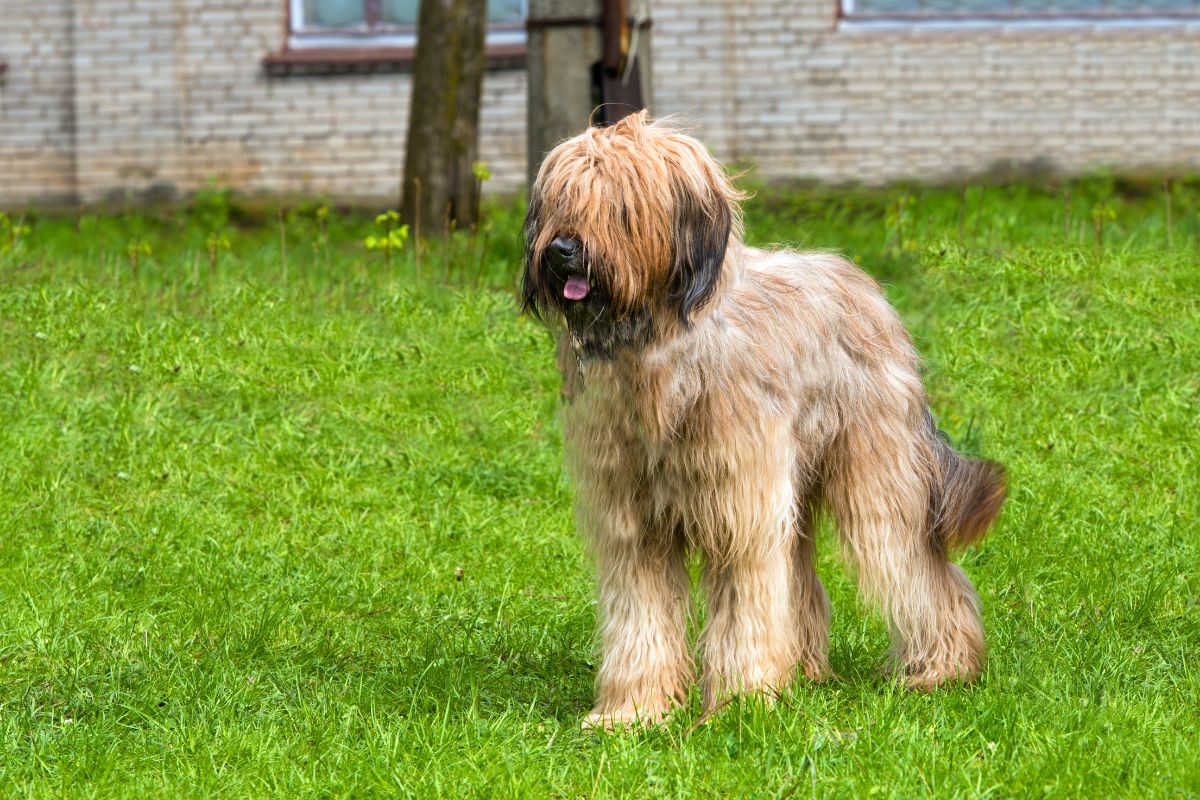
Cardigan Welsh Corgi
Most people are unaware that there is another breed of Welsh Corgi! The Cardigan Welsh Corgi, developed in Wales, is the older of the two Corgi breeds. The tail is the primary distinction between the two. The tails of Pembrokes are short and stubby, whereas those of Cardigans are longer.
In addition to red, black, sable, and merle, Cardigans have coats in a wider range of colors. Many believe they descend from the same family as Dachshunds and Basset Hounds. The ancestor of the Cardigan Welsh Corgi arrived in Wales more than 2,000 years ago.
Cardigan Welsh Corgis, like Pembroke Welsh Corgis, are susceptible to back injuries and disorders, necessitating special care and veterinary visits to avoid health complications.
Also, they are not as receptive to strangers as Pembroke Welsh Corgis, but they can be just as friendly with time and patience. They also have waterproof coats but are less suited for outdoor activities than Pembrokes.
Caucasian Shepherd Dog
Caucasian Shepherd Dogs, also known as Russian Bear Dogs, are massive, powerful dogs native to Russia’s Caucasus Mountains. They are also the Russian Caucasian Ovcharka, Caucasian Mountain Dogs, and Caucasian Ovcharka. They are large and muscular, with a thick, fluffy, multicolored coat.
This coat is so thick that it makes Caucasian Shepherd Dogs appear even larger than they are. Being one of the oldest breeds, they have existed for at least 2,000 years. Archaeological evidence suggests that the breed originated in Mesopotamia.
The Caucasian Ovcharkas are, at best, courageous and, at worst, ferocious. They may not be as energetic as other Shepherd dogs, but they will unleash their full strength if pushed too far.
Also, they are extremely wary of strangers but interact joyfully with family and friends. You should not leave children alone with a Caucasian Shepherd Dog, as they may begin to guard the child with excessive vigilance. They can make excellent family pets and guardians if correctly socialized and trained.
Dutch Shepherd
One cannot deny the eerie resemblance between the Dutch Shepherd and America’s favorite Shepherd, the GSD. It was so confusing that the breed standard changed, making them easier to distinguish.
In contrast to its German Shepherd relatives, the Dutch variety originated in The Netherlands, as its name suggests. They were the ideal all-around Shepherds who protected farms and drove sheep. At home, they would also protect the children!
However, the Dutch Shepherd’s popularity as a farm dog did not last. In the 1900s, the rise of industrialization eliminated the majority of farmland. Thankfully, the adaptability and skills of these dogs made their integration into society seamless.
Like German Shepherds, Dutch Shepherds became police dogs, military assistants, and search and rescue dogs. Today, many of them also serve as devoted guide dogs. Despite these new opportunities, many Dutch Shepherds herd in rural regions.
English Shepherd
English Shepherds were for herding livestock during the Roman Empire. According to legend, the English Shepherd is a herding dog breed that dates back to the Roman Empire in 55 B.C.
The breed originated when dogs from the Roman Peninsula arrived in the British Isles with Caesar’s army. The dogs were helpful in herding animals during these invasions.
As livestock dwindled, natives of the British Isles interbred Roman dogs with local breeds to demonstrate the intelligence and agility that result from breeding dogs. The resulting strain arrived in the New World through British immigrants. The English Shepherd’s reputation as a skilled herder and rat-catcher earns it a place on numerous farms.
The English Shepherd is eager to please and makes a wonderful family pet. However, without proper socialization with humans and other animals, the English Shepherd can become dominant and act as the alpha dog.
The English Shepherd also requires daily walks and ample yard space for exercise. In comparison to other herding dog breeds, the English Shepherd’s coat is simple to maintain and requires only occasional brushing.
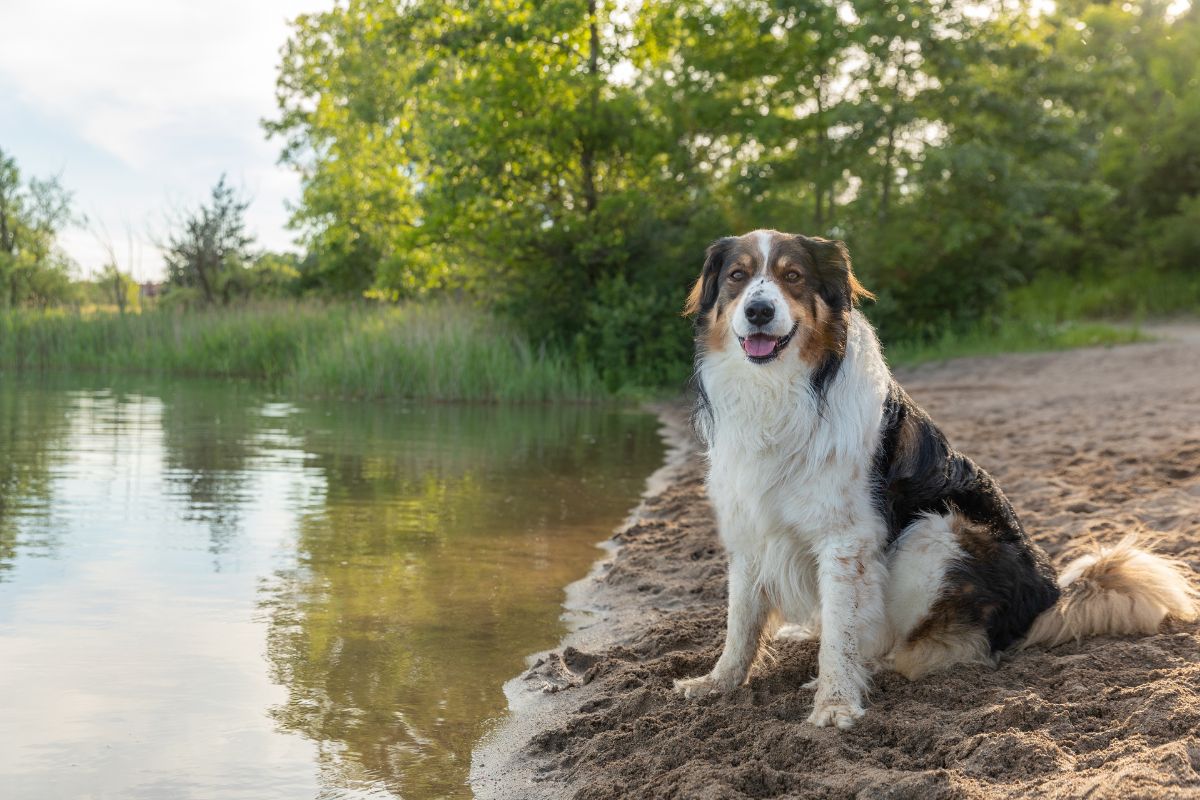
Finnish Lapdog
Originally bred to herd reindeer, Finnish Lapphunds are extremely adroit dogs. Their name says it all: the Finnish Lapphund is native to Finland, along with the Saami people of Lapland’s far north.
Before World War II, Finnish Lapphunds were on the verge of extinction, but enthusiasts banded together to save the breed. They are incredibly agile and can transition from walking to sprinting instantly.
Finnish Lapphunds have coarse, long guard hairs and soft, insulating undercoats that keep out the cold. They are available in numerous colors, from white to red to brown to black. They are family-oriented, good with children, and wary of strangers.
However, they are not guard dogs; they bark at strangers but do not attack. Finnish Lapphunds require the same daily exercise as the majority of herding breeds. Someone should always watch the Lapphund, lest they become anxious and display destructive behavior when left alone.
In addition, they have a strong “startle” reflex from avoiding reindeer. So, a responsible owner will keep them away from loud noises and dangerous situations. As long as one can tolerate the shedding and the barking, Finnish Lapphunds are lovely family pets.
German Shepherd Dog
German Shepherds are large, agile, and extremely intelligent animals that make excellent working dogs. They are the most well-known Shepherd breed in the world. They are athletic, quick, and smart.
German Shepherds originated from Germany in the late 1800s by crossing various herding breeds. During WWII, they were the preferred military breed. German Shepherds are now used for everything from seeing-eye dogs to K9 units.
German Shepherds are typically 26 inches (66 centimeters) tall at the shoulder and have a double coat. Most have black and brown coats with darker colors on the back and muzzle. They can also have entirely black coats.
Additionally, these dogs are brave and intelligent. They quickly learn new skills and are always eager to keep up with an active owner. Also, you must socialize these dogs from a young age to avoid them becoming nervous and high-strung. This entails exposing them to children and other animals to break them of their overprotective instincts.
They also need a lot of exercise and daily walks to stay mentally and physically fit. German Shepherds shed about twice a year, but you must brush them several times weekly. On the other hand, well-bred German Shepherds do not snore or drool, and they are less likely to dig up your garden!
Great Pyrenees
Great Pyrenees dogs get their name from the ancestral mountain range, the Great Pyrenees.
Technically a livestock guard dog instead of a herder, the Great Pyrenees is a massive dog with an immense sense of duty.
In the United Kingdom, people call them Pyrenean Mountain Dogs. This breed originated in the French-Spain region bordering the Pyrenees Mountains. Their white, shaggy coat is ideal for repelling cold and moisture.
Several centuries ago, Great Pyrenees dogs were the best working dogs. In 1675, however, the court of King Louis XIV designated the Great Pyrenees as the French royal dog. This allowed the French nobility to acquire and utilize these large canines as guard dogs.
Great Pyrenees are not suitable for inexperienced dog trainers. Even though they are calm and submissive in safety, their strong sense of individuality and size may make discipline challenging.
Like a German Shepherd, a Great Pyrenees requires extensive socialization to distinguish between friends and foes. Great Pyrenees can be the most pleasant dogs if correctly socialized.
They also require a specialized low-protein diet as they are prone to bloat. Those who wish to raise a Great Pyrenees must also be ready for their ferocious barks and howls. They are incredibly vocal, and their calls can travel great distances. This makes perfect sense, as they lived in the mountains!
Icelandic Sheepdog
The Icelandic Sheepdog has one of the oldest histories among Shepherd breeds, dating back over a thousand years. As their name suggests, these Sheepdogs developed their full potential in Iceland. They were not, however, indigenous to the island. Historians say these dogs reached the northern peninsula through Norse settlers.
In addition to bringing their mysterious Nordic culture, they also brought sheep- and pony-rounding spitz-type breeds. Today, this fan-favorite Shepherd remains popular in Iceland. They are an enduring part of the island’s cultural heritage and a national symbol. However, this is not the reason why many people love them.
Many people love Icelandic Sheepdogs because they are friendly, all-around family pets. The dog’s positive attitude and energy will undoubtedly make you smile. In addition, they are famous for an unwavering loyalty that few other dog breeds can match.
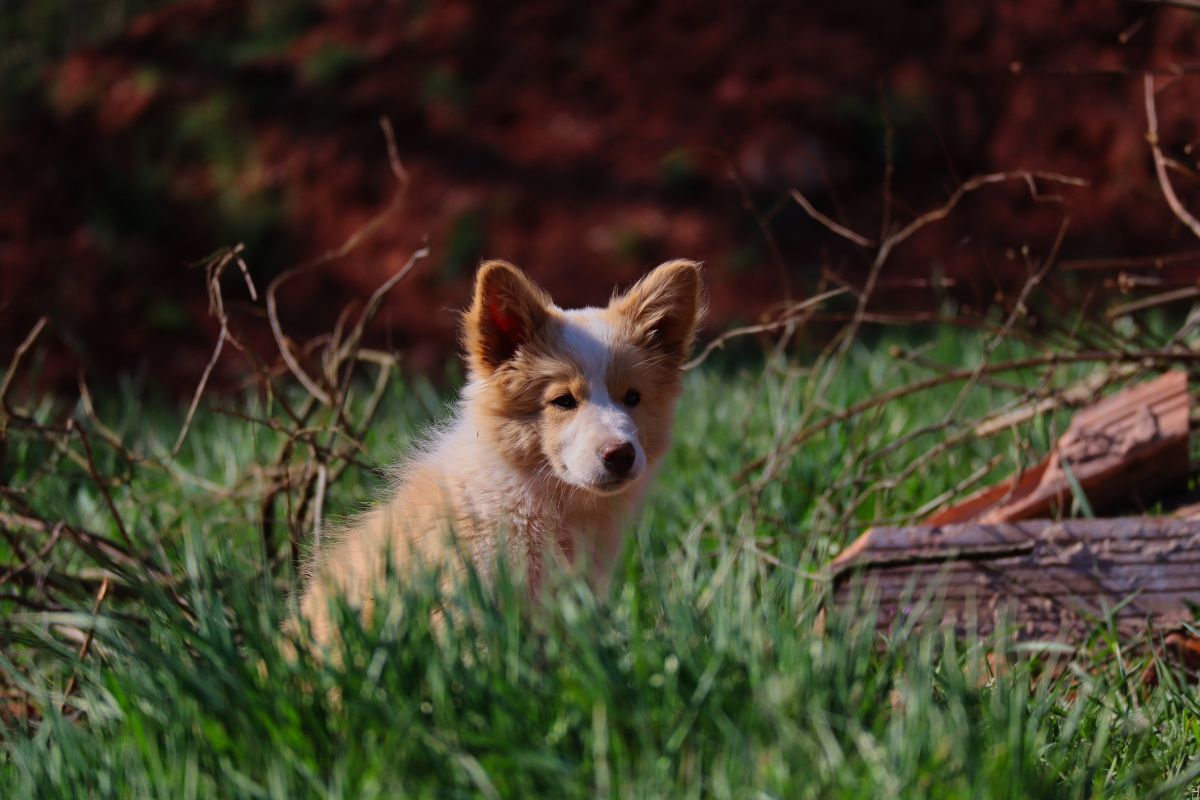
Old English Sheepdog
Old English Sheepdogs are also known as Bobtails. They are readily identifiable by the shaggy hair that frequently covers their eyes. Shepherd’s Dog and Bob-Tailed Sheepdog are among their former names. These large, shaggy dogs’ origins are unclear, though many sources believe they originated in southwest England as cattle herders.
Old English Sheepdogs are playful, friendly dogs that enjoy spending time with their families. They are good with children and do not tend to be overprotective; their protective instincts activate only when necessary. They adapt surprisingly well to home and apartment life.
Even though this breed sheds little, the volume of their fur necessitates extensive weekly grooming. This includes daily brushing and sporadic trips to the groomer. The Old English Sheepdog does not do well when left alone for long periods; they develop social anxiety rapidly and must be with their family almost constantly.
Pembroke Welsh Corgi
The Pembroke Welsh Corgi is among the world’s most popular herding breeds. This dog is one of the shortest herding breeds, with a shoulder height of only 10 to 12 inches (25.4 to 30.5 centimeters). The British royal family favors these Corgis; Queen Elizabeth II raised Welsh Corgis at Buckingham Palace!
Pembroke Welsh Corgis originated in Pembrokeshire, Wales. These tiny herders have short, waterproof coats, small legs, stubby tails, witty humor, and a desire to participate in family activities.
Pembroke Welsh Corgis are hardy canines that require minimal grooming. Due to their adventurous nature and desire to be in the thick of things, you can frequently find them in unusual places, such as tables and couch-backs.
Due to their herding nature, Pembroke Welsh Corgis may chase and bite children, so you must take precautions to prevent them from exerting too much pressure on children. Also, they are very vocal; they may bark excessively when bored. Corgi body structures also make them susceptible to back issues.
Polish Lowland Sheepdog
The Polish Lowland Sheepdog, renowned for its shaggy coat, loves to work and play hard. Although medium-sized, Lowland Sheepdogs are compact and hardy workers who thrive in fields with much larger livestock.
Many believe Polish Lowland Sheepdogs are the offspring of Hunnic and regional dogs (Poland). They excelled at herding sheep and served as the flock’s guardians and protectors.
Thankfully, the Polish Lowland survived to the present day. Opposing these herding dogs is difficult due to their cheerful demeanor and compassionate nature. They may retain some family-protective instincts, but they are generally friendly dogs.
Puli
The Puli may have a comical appearance. Also, it may resemble a friendly, four-legged mop to most people. The Puli is an ancient Hungarian breed related to the Tibetan Terrier introduced to Hungary in 900 CE.
Like the Spanish Water Dog, the Puli’s coat is curly and grows in tightly coiled cords, though it is significantly thicker. Regardless of the color of the coat, the Puli’s skin is fully pigmented blue or black. They were solitary companions on hilltop ranches and tended to bond with a single individual.
Pulik (plural of Puli) are intelligent and assertive; they may be too clever for their own good sometimes! Pulik tend to circle their “flock,” biting the cattle that stray too far from the group. They always return to their owners, regardless of whether they are investigating something or simply playing.
Due to the density of their corded coat, Pulik tend to overheat in hot weather. Additionally, you must supervise them closely if they go swimming, as the cords can weigh them down and tire them out. Pulik are remarkably agile and acrobatic, and they enjoy running around in wide-open spaces, despite their thick coat, which makes grooming difficult.
Rough Collie
Long-haired Collie is another name for the Rough Collie. Possibly the most well-known example of this Collie variety is Lassie, the protagonist of the 1950s television series of the same name. You can distinguish Lassie and other Rough Collies from other herding breeds by their wedge-shaped heads, almond-shaped eyes, and impressive mane-like coats.
The Rough Collie descended from Scottish and Welsh Sheepdogs. Throughout the 1800s, the Rough Collie was the preferred herding dog in Scotland and Wales until the second Industrial Revolution. Their name changed to Scotch Sheepdogs, and they became household pets.
Over time, Rough Collies have been more of companion animals rather than working dogs. They, unlike typical herding dogs, lack the characteristics required for herding. A well-trained Rough Collie will bark but not attack strangers.
As long as they receive daily walks, Rough Collies can adapt to various living situations, including apartment living. However, given that they are among the long-haired Shepherd breeds, they will require frequent brushing and bathing to prevent their long hair from matting.
In addition, acquiring a Rough Collie from a reputable breeder is essential, as the explosive popularity of the original Lassie resulted in many unscrupulous breeders who care little for dogs and more about money.
Shetland Sheepdog
The Sheltie closely resembles its slightly larger cousin, the Rough Collie. It commonly bears the name Sheltie. Its original name was the Shetland Collie, but Rough Collie breeders fought to change it. Shelties descend from the highland dogs of Scotland and Norway. The Norwegians formerly referred to them as Toonies.
They went to the Shetland Islands, bred to be smaller and fluffier through cross-breeding. Increasingly interbred, the Shelties lost their original appearance by the end of the 19th century. The American Kennel Club registered the first official Sheltie in 1911.
Additionally, Shelties are family-friendly and get along well with children and the rest of the household. They are also highly athletic and excel in agility and obedience competitions. However, because they were for herding sheep, they can chase birds and anything that resembles them, including toy airplanes.
Shelties are also heavy shedders, so prospective Sheltie owners must invest in an excellent vacuum cleaner. They can tolerate some time alone if they receive great affection and cuddles when everyone is home.
Spanish Water Dog
The Spanish Water Dog possesses strong instincts for protection. It is a woolly, intelligent, and even-tempered working dog. The most notable trait of the Spanish Water Dog is its wooly coat. These coiled fur strands wind around one another and form cords. Due to this, farmers used to shear their dogs simultaneously with their sheep!
Also, their origins are somewhat obscure, with various theories placing them in Turkey or Northern Africa. Nonetheless, they established themselves as sheepherders and waterfowl retrievers on the Iberian peninsula. Today, police forces and disaster rescue teams also utilize them.
The Spanish Water Dog is an excellent family companion. These dogs are intelligent, eager to please, and possess intense hunting and protection instincts. This also implies that the owner must be at the top of the pack hierarchy to prevent their dog from becoming excessively territorial or possessive.
Notably, you should never comb or brush this dog, as this could cause pain to the curled furs. A proper bath should include copious amounts of conditioner and mild shampoo. This breed sheds very little, making them one of the few hypoallergenic dog breeds.
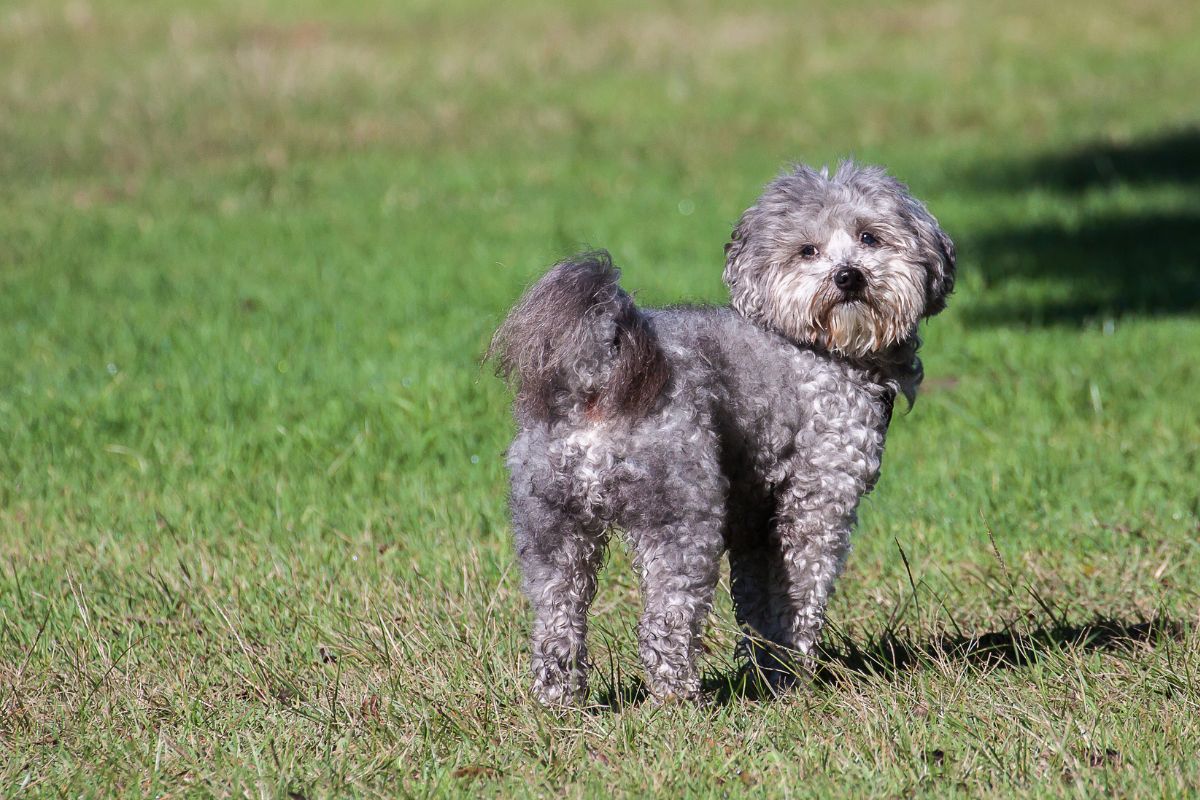
What is the Largest Shepherd Breed?
The Anatolian Shepherd is the largest of the Shepherd dog breeds, standing 27 to 29 inches (68.6 to 73.7 centimeters) tall and weighing around 150 pounds (68 kilograms).
Which Shepherd Dog Breed is the Smallest?
The American Miniature Shepherd is the smallest Shepherd breed. It appears to be a miniature Australian Shepherd. Despite their small stature, they are true herders, intelligent, self-motivated workers, and endearingly loyal and active companion dogs with a fondness for horses.
The Miniature American Shepherd and its ancestor, the Australian Shepherd, share many physical characteristics, albeit on a smaller scale. At the shoulder, females measure between 13 and 17 inches (33 and 43.2 centimeters), while males range between 14 and 18 inches (35.6 and 45.7 centimeters).
Despite their size, small Shepherd breeds possess all the characteristics of a true herding dog: they are energetic, adaptable, rugged, and extremely intelligent. This striking coat is available in black, blue, red, and red.
The merle coat can display any quantity of marbling, specks, or blotches. Minis move with a dog’s smooth and agile gait, adapted for hard work on harsh terrain.
What is a Shepherd Dog?
Shepherd dogs are primarily herding animals. But not all herding breeds are Shepherd dogs. Confusing? Shepherd dogs refer to a specific type of herding dog that drives sheep.
For instance, the Finnish Lapphund is one of the best herding dogs in the world. However, technically they are not a Shepherd dog breed. The Finnish Lapphund was originally for herding reindeer! However, most others specialize in livestock.
This does not mean that cattle herders cannot also herd sheep. Many cattle dogs, including the Blue Heeler, can and do herd both types of livestock. Frequently, a Shepherd will evolve into a herder of cattle, ponies, birds, and other animals.
The Shepherd Dog’s Temperament
Each dog breed has a unique temperament and personality. Individual dogs of the same breed frequently exhibit variations, much like humans. Nonetheless, these dogs share many similar characteristics.
For instance, Shepherd breeds are typically active and lively. These dogs were, after all, bred to spend hours chasing farm animals around a farm. To be successful at their jobs, they had to be highly active.
In addition, Shepherds are typically vigilant, obedient, and extremely intelligent. All of these characteristics contribute to their unique skill set. As many Shepherd dogs demonstrate, confidence is crucial for herding sheep. This is why they are fearless when approaching larger animals.
Shepherd Dog Instincts to Herd
Shepherd dog breeds are born with an instinct to herd. These breeds have performed this task for generations. Consequently, their herding instincts have become deeply ingrained in them.
Even if the Shepherd dog has never encountered livestock, you may observe these instincts daily. For instance, it is common for herding dogs to bite the heels of young children or adults. In the end, this is how the majority of them behave.
The generic “do not bite” training is ineffective with this behavior. This is not a playful behavior; it is an instinct. It appeals to the dog as if it were hungry or thirsty.
Other Shepherd dogs, like the New Zealand Huntaway, bark to herd sheep. Many do this because it effectively communicates the dog’s location to the flock. Additionally, barking is a great way to move livestock without approaching them.
Due to this, Shepherd breeds typically have an eager bark. In other words, they do not fear barking and use it as their primary method of communicating with humans. Even though this may annoy most owners, it is simply from their breeding.
What’s the Difference Between a Sheepdog vs. a Shepherd Dog?
Many individuals incorrectly use the terms sheepdog and Shepherd interchangeably. However, although they are not similar, we acknowledge that the two terms can be confusing.
As we’ve already discussed, Shepherd dogs herd by driving sheep flocks into formation and directions. These dogs are traditional herders, such as Border Collies and Australian Shepherds.
Alternatively, a sheepdog is typically associated with dogs that herd sheep. In addition to moving sheep, they also guard and protect them. Some even believe they are part of the flock because they live closely with it.
Final Words
Even though many dogs are capable of shepherding a flock, few are genetically predisposed to do so. If you have a small farm or homestead, any Shepherd-type dog breeds covered in this article can keep your other farm animals secure and contained.
It is essential to remember that Shepherd breeds come in various sizes and colors. In addition, the temperament of each breed and even each Shepherd puppy varies. To prepare for each dog’s challenges, it is essential to research its breed.
Additionally, a healthy respect for the unknown is essential. Each dog is unique, so a well-informed owner will know how to adapt to each breed.

